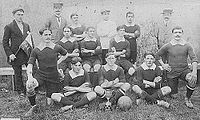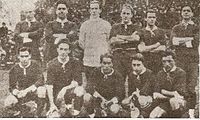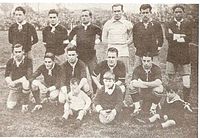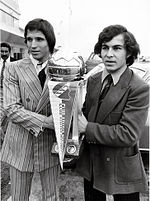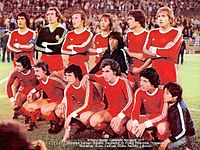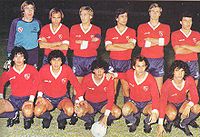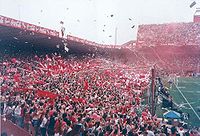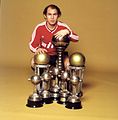- Club Atlético Independiente
-
Independiente 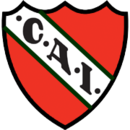
Full name Club Atlético Independiente Nickname(s) El Rojo (The Red)
Los Diablos Rojos de Avellaneda
(Avellaneda's Red Devils)
El Rey de Copas (The King of Cups)
El Orgullo Nacional
(The National Pride)Founded 1905, as Independiente Football Club Ground Estadio Libertadores de América,
Avellaneda, Buenos Aires, Argentina
(Capacity: 44,000[1])Chairman Julio Comparada Manager Ramón Díaz League Primera División 2011 Clausura 6th Website Club home page Home coloursAway colours Current season
Current seasonClub Atlético Independiente (Spanish pronunciation: [ˈkluβ atˈletico indepenˈdjente]) is an Argentine athletic, sports and social club, which has its headquarters and stadium in the city of Avellaneda, Buenos Aires Province. The club is best known for its football team, that plays in the Argentine Primera División.
In football, Independiente is considered one of the "Big Five" clubs of Argentina. It is the third team with most national league titles in the country (14, the last one being the 2002 Apertura), and have also won 16 international competitions (the last one being the 2010 Copa Sudamericana). Independiente is also one of the two teams that has never been relegated from the Argentine Primera. Independiente is also the club that has won most Copa Libertadores, the most important club tournament in South America, having won the competition seven times. The club is also the only four-time consecutive champion. Additionally, they have won three times the Copa Interamericana, twice the Supercopa Sudamericana, once the Recopa Sudamericana, twice the Intercontinental Cup (1973 and 1984), and once the Copa Sudamericana (in 2010, after 16 years without international wins).
Independiente was officially founded on January 1, 1905, although the institution had been formed on August 4, 1904, and already played in Argentina's first division. The club was originally from Montserrat, a historic neighborhood of Buenos Aires. Its stadium, formerly called La Doble Visera de Cemento (English: "The Double Cement Visor") was built in 1928, but has been completely remodeled but still not completely finished. The club has renamed it Estadio Libertadores de América, after conducting a poll between supporters to determine the new name.
Contents
History
Foundation
In 1904, the employees of a store located in Monserrat had founded the Maipu FC, a football club. The most young employees only were allowed to watch the games but they could not play for the team. Because of that, they met in a bar located in front of the club and decided to break apart and to found a new club. The name chosen was "Independiente" ("Independent" in Spanish) to remark their independence from the Maipú FC.
Rosendo Degiorgio was appointed interim president. The club gave a small room in his home district of Montevideo 1585 (Recoleta), to be the first clubhouse. There were the first meetings.
It was decided to call the first meeting at which it was established that will formalize the establishment of the club for Sunday January 1, 1905, at home partner Daniel Bevilacqua (Esmeralda 329, 3rd floor). On March 25, 1905 was first elected president of the institution, who would Aristides Langone. They had neither indispensable for the functioning of the same, but looked to their family and friends to the new members of the club. They made an effort to make it grow. It needed a record label and a leather ball, got them. Fortunately they should not pay money for the purchase of sports uniforms, and Langone Aristide gave the institution that belonged to his former club which by then was dissolved, the United Plate FV. This uniform was white, and his shield was adapted from that used the first football champion Argentina, the Saint Andrew's F. C.
Had a first humble sports ground in Boyacá and Shrimp (North Flores in 1905, Villa General Mitre today). In mid-1905 it moved to its second site, which is in Avenida San Martín, Donato Alvarez, also in Villa General Mitre. The third field in which they were left in the neighborhood of Palermo. Was an area of the National College West (now Mariano Moreno), on the corner of Avenida Alvear Avenida del Libertador-today-and Tagle. He took over late 1905 and remained there until April 1906. At that site is up, years later, a stadium of Club Atlético River Plate Estadio Monumental Antonio before Vespucio Liberti. The fourth was in Espinosa and Paysandú (in the neighborhood of La Paternal, there were from May 27, 1906 until the end of that year. Just at the beginning of 1907, settled in Avellaneda, on land located at Manuel Ocantos 540).
Early Years
Independiente played its first game on Sunday January 15, 1905, against Atlanta, in the "bohemios" field, losing 1-0. The next game was played on January 22, 1905 against Maipú Banfield F.C., which ended in a 0-0 draw. The club won the first game in its history with a resounding 11-0 against Albion on May 7, 1905. Affiliated to the The Argentine Football Association, Independiente was allowed to play in the second and third division. The team at second played regularly but the squad at third division suffered a catastrophic defeat at the hands of Atlanta by 21-0.
However, the team was reorganized and played the first "Avellaneda Derby" in history, disputed on June 9, 1907. Independiente beat Racing 3-2, although Racing supporters had predicted their team would win by a large result.
That same year Independiente moved to its new field located in Avellaneda, which was built in Manuel Ocantos street. On May 10, 1908, the team played for the first time wearing the red jersey, in match against Banfield that Independiente won 9-2. Red color was adopted because of the identification of some of its founders with the socialist movement. In 1909, the Independiente team that took part in the Second Division won the Copa Bullrich, the first official trophy. Buruca Laforia Joseph, former seven-time Alumni's goalkeeper, was part of the team.
On July 9, 1911, the club moved into its sixth field, which was also in La Crucecita district, more precisely in Mitre Avenue. It was celebrated with a match against Estudiantil Porteño, which Independiente won 1-0.
Independiente promoted to first division for being one of the two founder members (along with Gimnasia y Esgrima de Buenos Aires of the Federación del Fútbol Argentina. The club would never be relegated to lower divisions up to the present moment. The following year Independiente won its first title in primera, being Ernesto Colla its top scorer.
From white to red
 Independiente's first crest, still used when wearing the away outfit.
Independiente's first crest, still used when wearing the away outfit.
Independiente's original shirt was half blue and half white, with blue shorts, but in 1907, when President Arístides Langone saw Nottingham Forest's red outfit, he decided to give Independiente a new look. Langone thought they looked like "red devils", which would later become Independiente's nickname. In 1908, in a match against Bristol of Uruguay (black-white stripes), Independiente wore the red outfit for the first time, having also changed their original name to Club Atlético Independiente. The original outfit is used as the second kit, using even the original logo.
Amateur Era
The stadium La Crucecita had been built in 1910 and destroyed by fire in 1923. By those years the "Avellaneda derby" was the most popular match in Argentina, even more than the "Superclásico", as these clubs were involved in separate leagues until the arrival of professionalism faced only occasionally.
During the amateur era, Independiente won two titles, in 1922 (its first official trophy in Primera) and 1926 (where the team finished undefeated). Some notable players of those times were Manuel Seoane (all-time top scorer of amateur era) and Raimundo Orsi. It was during the 1926 tournament that Independiente was nicknamed "Diablos Rojos" ("Red Devils") for the first time. This nickname came from journalist Hugo Marini [2], who worked at Crítica newspaper. Marini had stated that the forward line "was like possessed by the Devil" due to its skilled players that formed it. This nickname was accepted by followers and has remained since as the most popular nickname of the team.
Independiente also won the Copa de Competencia Jockey Club (which succedeed an old version that "The Diablos" had won in 1917) in three consecutive times: 1924, 1925 and 1926. In 1927 the team reached the Campeonato Porteño finals.
In 1928 the club began to built its seven (and last, to date) stadium. t is believed that managers chose concrete because unlike wood (the material of his previous stage) was a non-combustible material, and therefore would not suffer another fire. This stadium was officially opened on March 4, 1928, and it was the first stadium built in cement in Latin America (and the 2nd. Worldwide). The stadium was soon nicknamed as "La Doble Visera" ("The Double Visor") by journalists.
Beginning of professional era
In 1931 the professional era of Argentine football began. The first professional match was an 1-1 draw against Argentinos Juniors and the following match Independiente achieved its first victory, a 3-1 over Huracán. At the end of the championship the first "Avellaneda derby" of professional era was played: it was won by Racing 7-4.
In 1937 Vicente de la Mata, one of the most notable players in history, arrived to the club. With his contribution, Independiente won its first professional titles, in 1938 and 1939. Paraguayan forward Arsenio Erico was the all-time top scorer of the Argentine football with 295 goals in official matches, which is still a record. He had an average of 40 goals by season. Moreover, Erico was the top scorer of 1937, 1938 and 1939.
Independiente also won two Copa Ricardo Aldao, which was disputed between champions from Argentina and Uruguay, and the winner was proclamed as Campeón Rioplatense. The squad defeated Peñarol in 1938 and Nacional in 1939.
The 1940s and 1950s
During the 1940s Vicente de la Mata became a great player, which caused he was nicknamed "Capote", and a Tango with the same name was composed honoring him. Manuel López (lyrics) and Juan Sánchez Gorio (music) were the authors. In those times Independiente achieved several overwhelming victories. Some of them were the 8-1 over Estudiantes de la Plata, a 5-0 to Vélez Sársfield, a 7-1 to Boca Juniors and the 7-0 to Racing Club, which is still the highest score in a Avellaneda derby. In 1941 Antonio Sastre left the club after playing 340 games for Independiente, and the following year it was Arsenio Erico who returned to Paraguay.
Independiente won a new title in 1948, defeating Racing 1-0 in the last fixture. At the end of the decade Ernesto Grillo (one of the most remembered players in the history of the club), made his debut.
In 1953 Independiente went on a European tour, which most outstanding victory was the 6-0 over Real Madrid (with Alfredo Di Stéfano as team's biggest star). Despite having toured successfully, the squad did not win any title in Argentina. Its best position was the 2nd. place in 1954.
The conquest of America and local titles
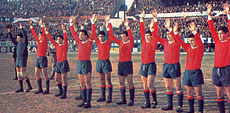 The team that won its second Copa Libertadores in 1965.
The team that won its second Copa Libertadores in 1965.
Independiente started the 60s with a league title, and then another in 1963. At that time, Independiente had more than 45,000 members, a remodeled stadium, and kept growing institutionally. But one of Independiente's greatest achievements would be in 1964, by becoming the first Argentine team to win the Copa Libertadores. Independiente repeated the title in 1965.
1967 would see Independiente win the Nacional tournament. This team would be one of the last few teams that used a 2-3-5 formation. The consagratory match would be in the Avellaneda derby nonetheless, against Racing Club. The game was won by Independiente 4-0.
Again, Independiente started a new decade by winning a title (Metropolitano 1970). The 70s would be Independiente's Golden Era by obtaining 12 important titles: Metropolitano 1970, 1971, Nacional 1977, 1978, Copa Libertadores1972, 1973, 1974, 1975, Intercontinental Cup 1973, and Copa Interamericana1973, 1974, 1975.
Independiente greatest achievement in the 70s was to win the Copa Libertadores four times in a row. Also, the team would become famous by having the Ricardo Bochini-Daniel Bertoni attacking duo.
But Independiente's most memorable game was the final match of the Nacional of 1977 tournament, even though the match was played in January the 25th of 1978. The final was against Talleres de Córdoba. The first leg was a tie (1-1) at Independiente's stadium and in the final match in Córdoba, the match was tied on one goal apiece, but with only 15 minutes remaining Talleres scored a controversial goal. As a result, Independiente's players protested, but instead the referee gave the red card to three of the players. With only 8 players playing and a few minutes remaining, Independiente tied the game with an incredible goal by Bochini, assisted by Bertoni. Independiente became the champion by the away goal difference rule.
In 1983, Independiente would win another Metropolitano tournament. Then in 1984, the club would obtain its seventh Copa Libertadores and became the team with won that tournament most. Independiente then played against Liverpool F.C. in Tokyo, Japan, for the Intercontinental Cup. The game ended in a victory for Independiente by 1-0, therefore winning the trophy for the second time.
The last important title that Independiente obtained in the 80s, was the 1988-89 season. Coached by Jorge Solari, the squad's most notable players were Bochini as the team strategist and Carlos Alfaro Moreno being the top scorer of the season. Independiente played a total of 38 matches, winning 22, with 11 draws and being defeated 5 times. The team scored 58 goals and received 32.
1990s to present
The 90s started with the retirement of Ricardo Bochini in 1991. A one club man, in his 20 years of professional football from 1972 to 1991 Bochini played only for Independiente (and the national team), and participated in the club's Golden Era, with 8 international titles, and 4 Argentine championships. He played a total of 740 matches and scoring 107 goals.
Independiente would then win the Clausura 1994, the Supercopa 1994 and 1995, and a Recopa 1995. After winning the Recopa, Independiente then claimed 15 international titles.
After a 7 year drought without winning any important title, Independiente became champions of the Apertura 2002. This team, coached by Américo Gallego, had an offensive playstyle designed by Federico Insúa, Daniel Montenegro, Andrés Silvera, among other important Argentine players.
Even though Independiente obtained an Argentine title in 2002, the club is going through hard times. The club has a serious debt that has been accumulating since the 90s. At first, it was said that the debt was more than 50 million dollars, but in February 2006, the Argentine justice established that the debt was around 26 million. With the transfer of Sergio Agüero to Atlético de Madrid for about 23 million euros, Independiente is hoping to pay off the debt. The club is taking its last steps into coming out of receivership.
The 2006-07 season started with a lot of enthusiasm. With former star Jorge Burruchaga as the team manager, and notable players such as Daniel Montenegro, Germán Denis and Óscar Ustari, it was expected that the team would fight for the titles. The Apertura finished with Independiente in a fourth place, despite a very irregular campaign, which included a home loss against Gimnasia y Esgrima Jujuy in the last match ever played in the historic Libertadores de América Stadium.
The Clausura 2007 tournament was a total catastrophe. Having earned just 8 points in the first 10 matches, manager Burruchaga resigned after a home loss 0-2 against the modest Godoy Cruz de Mendoza. Miguel Ángel Santoro became the interim coach. The team finished unbeaten with him, winning 4 matches and the other 5 resulting in ties. Independiente finished 11th in the tournament, and missed classification to Libertadores and Sudamericana Cups by just 2 points.
Claudio Borghi took over as manager of the team in 2008, despite a good start, Borghi resigned after losing 3 matches in a row he was replaced by Miguel Angel Santoro in his fourth spell as manager of the team. Many players were brought to revert the horrible 2007 campaign. Higher profile players such as Federico Higuaín, Leonel Rios, Emmanuel Centurion, Leandro Depetris, Leonel Nuñez and Dario Gandin were brought but the performance was not as expected. They were eliminated from the Copa Sudamericana in the 1st round and had three consecutive defeats in the 2008 Apertura (Newell's 0-1, 0-2 against Lanus and Huracan 0-1) that finalized the blow that was seeing the team fail to secure a top spot or enter an international competition .
The Reds were led by Americo Gallego, who left the champion with Independiente in Apertura 2002 after Santoro's resignation after a few dates in the Clausura 2009. Under the leadership of Santoro, Independent is positioned at the 18th place of the 2008 Open over Rosario Central and River Plate 19 º 20 º. In summer, the club signed Eduardo Tuzzio and Paraguayan Diego Gavilan.
In Clausura 2009 Independiente had a very poor campaign in finishing 16th which angered a lot of fans.
Hopes were renewed for the Apertura 2009, due to the signings of talented striker Andrés Silvera, Carlos Matheu, Ignacio Piatti, and other 5 first level players. Coach Américo Gallego reduced the size of the squad, letting go of 17 players including star attacking midfielder Daniel Montenegro. Those moves paid off, and Independiente dinished the tournament with 34 points (4th).
For the Clausura 2010, Independiente's coach got some new important signings and were on top of the positions until nearly the end of the tournament. They ended up in the 4th position, and although the team qualified to the Copa Sudamericana, the board didn't offer Gallego a new contract.
The Apertura 2010 saw a very poor campaign for Independiente. The president, Julio Comparada, decided not to spend too much money on transfers as it was being spent on the works on the Estadio Libertadores de América. Moreover, some important players left the club, such as Ignacio Piatti, Darío Gandín, Walter Acevedo and Luciano Vella. General manager César Luis Menotti and head coach Daniel Garnero were sacked, and Antonio Mohamed was hired as coach. He gave a new look to the team after defeating their archrivals (Racing) 1–0. Even though the team stayed in the last positions of the domestic tournament, they advanced through the stages of the Copa Sudamericana, eventually winning the competition via penalty shootout in the final against Goiás.
The stadium
Main article: Estadio Libertadores de AméricaOn March 4, 1928, in a match against Peñarol of Uruguay that ended in a draw, Independiente established the first stadium in South America. The stadium would later be known as Doble Visera.
The Estadio Libertadores de América was closed for repairs in 2007, and reopened 28 October 2009 in a league match against Colón, which Independiente won 3-2. During construction, Independiente played their home games in four different fields.
Current squad
Current squad of Club Atlético Independiente as of November 13, 2011 ()
Sources: Official website and Argentine SoccerNo. Position Player 1  ARG
ARGGK Hilario Navarro 2  ARG
ARGDF Julián Velázquez 3  ARG
ARGDF Maximiliano Velázquez 4  PAR
PARDF Cristian Báez 5  ARG
ARGMF Roberto Battión 6  ARG
ARGDF Eduardo Tuzzio 7  ARG
ARGMF Cristian Pellerano 8  ARG
ARGMF Hernán Fredes 9  ARG
ARGFW Leonel Núñez 10  ARG
ARGMF Patricio Rodríguez 11  ARG
ARGMF Osmar Ferreyra 12  ARG
ARGGK Adrián Gabbarini 13  COL
COLDF Iván Vélez 14  ARG
ARGFW Gino Clara 15  ARG
ARGMF Fernando Godoy 16  ARG
ARGMF Nicolás Cabrera 17  ARG
ARGFW Facundo Parra 18  ARG
ARGDF Gabriel Milito 19  COL
COLFW Marco Pérez No. Position Player 20  ARG
ARGFW Matías Defederico 21  ARG
ARGGK Fabián Assmann 22  ARG
ARGMF Iván Pérez 23  URU
URUDF Adrián Argachá 24  ARG
ARGDF Leonel Galeano 25  ARG
ARGDF Carlos Matheu 26  ARG
ARGDF Ignacio Barcia 27  ARG
ARGDF Lucas Kruspzky 28  ARG
ARGDF Gabriel Vallés 29  ARG
ARGFW Francisco Pizzini 30  ARG
ARGGK Diego Rodríguez 31  ARG
ARGMF Lucas Villafáñez 32  ARG
ARGMF Walter Busse 33  ARG
ARGFW Patricio Vidal 34  ARG
ARGFW Brian Nieva 35  ARG
ARGDF Nicolás Delmonte 36  PAR
PARDF Samuel Cáceres 37  ARG
ARGFW Diego Churín Manager: Ramón Díaz
(Players ordered by number. These positions are generic and do not contemplate players that play multiple positions or more specific positions.)
Top scorers
The following tables lists the players that have been named top scorers playing for Independiente in Argentine First Division. Independiete has 15 top scorers, 5 in the amateur era and 10 in the professional era.
Amateur Era
The following players from Independiente had earned the individual distinction of being the top scorers of the amateur era of Argentine First Division:[3]
Tournament Player Goals 1912 Federación Argentina de Football  Ernesto Colla
Ernesto Colla12 1922 Asociación Amateurs de Football  Manuel Seoane
Manuel Seoane55 1924 Asociación Amateurs de Football  Luis Ravaschino[4]
Luis Ravaschino[4]15 1926 Asociación Amateurs de Football  Manuel Seoane
Manuel Seoane29 1929 Asociación Amateurs Argentina de Football  Manuel Seoane[5]
Manuel Seoane[5]13 Professional Era
The following players from Independiente had earned the individual distinction of being the top scorers of the professional era of Argentine First Division:[6]
Tournament Player Goals 1937 Primera División  Arsenio Erico
Arsenio Erico48 1938 Primera División  Arsenio Erico
Arsenio Erico43 1939 Primera División  Arsenio Erico
Arsenio Erico41 1956 Primera División  Ernesto Grillo[7]
Ernesto Grillo[7]17 1966 Primera División  Luis Artime
Luis Artime23 1967 Nacional  Luis Artime
Luis Artime11 1982 Metropolitano  Carlos Manuel Morete
Carlos Manuel Morete20 1999 Clausura  José Luis Calderón
José Luis Calderón17 2002 Apertura  Andrés Silvera
Andrés Silvera16 2007 Apertura  Germán Denis
Germán Denis18 Notable players
 This sports-related list is incomplete; you can help by expanding it.
This sports-related list is incomplete; you can help by expanding it.- To appear in this section a player must have made at least 50 appearances for the club.
 Raimundo Orsi (1920–28, 1935)
Raimundo Orsi (1920–28, 1935) Manuel Seoane (1921–33)
Manuel Seoane (1921–33) Roberto Porta (1931–33)
Roberto Porta (1931–33) Antonio Sastre (1931–42)
Antonio Sastre (1931–42) Arsenio Pastor Erico (1934–46)
Arsenio Pastor Erico (1934–46) Emilio Reuben (1937–41)
Emilio Reuben (1937–41) Vicente de la Mata (1937–50)
Vicente de la Mata (1937–50) Ernesto Grillo (1949–57)
Ernesto Grillo (1949–57) Rodolfo Micheli (1952–57)
Rodolfo Micheli (1952–57) José Varacka (1952–60)
José Varacka (1952–60) Rubén Marino Navarro (1952–66)
Rubén Marino Navarro (1952–66) Roberto Ferreiro (1958–68)
Roberto Ferreiro (1958–68) Raúl Bernao (1961–71)
Raúl Bernao (1961–71) Miguel Ángel Mori (1962–66)
Miguel Ángel Mori (1962–66) Miguel Ángel Santoro (1962–74)
Miguel Ángel Santoro (1962–74) Ricardo Elvio Pavoni (1965–76)
Ricardo Elvio Pavoni (1965–76) Idalino Monges (1966–70)
Idalino Monges (1966–70) Luis Artime (1966–68)
Luis Artime (1966–68) Aníbal Tarabini (1966–70)
Aníbal Tarabini (1966–70) José Omar Pastoriza (1966–72)
José Omar Pastoriza (1966–72) Héctor Yazalde (1967–71)
Héctor Yazalde (1967–71) Eduardo Commisso (1968–75)
Eduardo Commisso (1968–75) Miguel Ángel Raimondo (1969–74)
Miguel Ángel Raimondo (1969–74) Eduardo Maglioni (1969–73)
Eduardo Maglioni (1969–73) Luis Garisto Pan (1971–74)
Luis Garisto Pan (1971–74) Agustín Balbuena (1971–75)
Agustín Balbuena (1971–75) Francisco "Pancho" Sá (1971–76)
Francisco "Pancho" Sá (1971–76) Ricardo Bochini (1972–91)
Ricardo Bochini (1972–91) Daniel Bertoni (1973–78)
Daniel Bertoni (1973–78) Percy Rojas (1975–76)
Percy Rojas (1975–76)
 Enzo Trossero (1975–85)
Enzo Trossero (1975–85) Oscar Baquela (1976–79)
Oscar Baquela (1976–79) Hugo Villaverde (1976–91)
Hugo Villaverde (1976–91) Omar Larrosa (1977–80)
Omar Larrosa (1977–80) Antonio Alzamendi (1978–82)
Antonio Alzamendi (1978–82) Carlos Fren (1978–82)
Carlos Fren (1978–82) Jorge Olguín (1979–83)
Jorge Olguín (1979–83) Néstor Clausen (1980–88, 1995–96)
Néstor Clausen (1980–88, 1995–96) Ricardo Giusti (1980–91)
Ricardo Giusti (1980–91) Gabriel Calderón (1981–83)
Gabriel Calderón (1981–83) Carlos Manuel Morete (1982–83)
Carlos Manuel Morete (1982–83) Jorge Burruchaga (1982–85, 1995–98)
Jorge Burruchaga (1982–85, 1995–98) Carlos Enrique (1982–88)
Carlos Enrique (1982–88) Claudio Marangoni (1982–88)
Claudio Marangoni (1982–88) José Alberto Percudani (1982–88)
José Alberto Percudani (1982–88) Gerardo Reinoso (1983–87), (1992)
Gerardo Reinoso (1983–87), (1992) Franco Navarro (1986–88)
Franco Navarro (1986–88) Luis Alberto Islas (1986–95, 2003)
Luis Alberto Islas (1986–95, 2003) Rogelio Delgado (1987–92)
Rogelio Delgado (1987–92) Carlos Alfaro Moreno (1988–91), (1993–94)
Carlos Alfaro Moreno (1988–91), (1993–94) Sergio Vargas (1988–91, 1992)
Sergio Vargas (1988–91, 1992) Hermes Desio (1989–94)
Hermes Desio (1989–94) Claudio Borghi (1990)
Claudio Borghi (1990) Néstor Craviotto (1991–95)
Néstor Craviotto (1991–95) Gustavo Adrián López (1991–95)
Gustavo Adrián López (1991–95) Sebastián Rambert (1991–95, 2000–01)
Sebastián Rambert (1991–95, 2000–01) Daniel Garnero (1991–95, 1997–99, 2000–01)
Daniel Garnero (1991–95, 1997–99, 2000–01) César Velázquez (1992–94, 1995–97, 1998–99)
César Velázquez (1992–94, 1995–97, 1998–99)
 Eber Moas (1992–94)
Eber Moas (1992–94) Pablo Rotchen (1992–99)
Pablo Rotchen (1992–99) Hugo Pérez (1993–95)
Hugo Pérez (1993–95) José Serrizuela (1993–96)
José Serrizuela (1993–96) Albeiro Usuriaga (1994–95, 1996–98)
Albeiro Usuriaga (1994–95, 1996–98) Faryd Mondragón (1994–98, 1999-00)
Faryd Mondragón (1994–98, 1999-00) Roberto Acuña (1995–97)
Roberto Acuña (1995–97) Christian Díaz (1995-00)
Christian Díaz (1995-00) Jorge Daniel Martínez (1995–98, 2000–01, 2004–05)
Jorge Daniel Martínez (1995–98, 2000–01, 2004–05) Gabriel Milito (1997-03, 2011-)
Gabriel Milito (1997-03, 2011-) Esteban Cambiasso (1998-01)
Esteban Cambiasso (1998-01) José Luis Calderón (1996–97, 1998–99, 2003)
José Luis Calderón (1996–97, 1998–99, 2003) Diego Forlán (1998-02)
Diego Forlán (1998-02) Mariano Pernía (2000–02)
Mariano Pernía (2000–02) Matías Vuoso (2000–02)
Matías Vuoso (2000–02) Pablo Horacio Guiñazú (2001–03)
Pablo Horacio Guiñazú (2001–03) Andrés Silvera (2001–03, 2009–2011)
Andrés Silvera (2001–03, 2009–2011) Daniel Montenegro (1999, 2002–03, 2006–09)
Daniel Montenegro (1999, 2002–03, 2006–09) Federico Insúa (2002–03, 2004–05)
Federico Insúa (2002–03, 2004–05) Lucas Pusineri (2002–03), (2007–2009)
Lucas Pusineri (2002–03), (2007–2009) Sergio Agüero (2003–06)
Sergio Agüero (2003–06) Óscar Ustari (2005–07)
Óscar Ustari (2005–07) Germán Denis (2006–08)
Germán Denis (2006–08) Hilario Navarro (2007-)
Hilario Navarro (2007-) Eduardo Tuzzio (2009-)
Eduardo Tuzzio (2009-)
see also Category:Club Atlético Independiente footballers
Gallery
-
Arsenio Erico, the all-time Argentine football top scorer with 295 goals.
-
Ricardo Bochini, who played the most matches for the club (740).
-
Vicente de la Mata, who played 362 games for Independiente.
-
Antonio Sastre played 340 matches with the team.
-
Manuel Seoane, one of Independiente's top scorers with 241 goals.
-
Ernesto Grillo was other prominent player for the club.
Honors
- National
- Amateur Era (2): AAm 1922, AAm 1926
- Primera División (14): 1938, 1939, 1948, 1960, 1963, 1967 Nacional, 1970 Metropolitano, 1971 Metropolitano, 1977 Nacional, 1978 Nacional, 1983 Metropolitano, 1988–1989, 1994 Clausura, 2002 Apertura
- International
- Copa Libertadores (7): 1964, 1965, 1972, 1973, 1974, 1975, 1984
- Copa Sudamericana (1): 2010
- Recopa Sudamericana (1): 1995
- Intercontinental Cup (2): 1973, 1984
- Interamerican Cup (3): 1973, 1974, 1975
- Supercopa Sudamericana (2): 1994, 1995
- Other
- Elimination Competition (1): 1914
- Copa de Honor Municipalidad de Buenos Aires (1): 1918
- Copa Río de La Plata (2):1938, 1939
- Copa Dr. Carlos Ibarguren (2): 1938, 1939
- Copa Adrián C. Escobar (1): 1939
- Copa San Martín de Tours (1): 1963
- Copa DAIA (1): 2004
References
- ^ "New Stadium section" (in Spanish). Club Atlético Independiente's official website. http://www.caindependiente.com/nuevoestadio.html. Retrieved 2011-07-27.
- ^ [This journalist also nicknamed "El Fortín" to Vélez Sársfield Stadium]
- ^ [1] Historic Statistics from Argentine First Division.
- ^ With Ricardo Lucarelli, from Sportivo Buenos Aires, who also scored 15 goals.
- ^ With Juan Bautista Cortesse, from San lorenzo, who also scored 13 goals.
- ^ [2] GArgentine First Division Top Scorers, by the RSSSF.
- ^ With Juan Castro, from Rosario Central, who also scored 17 goals.
External links
Stadiums Rivals Key Personnel Chairman: Julio Comparada · Manager: Antonio MohamedNational Titles (14) 1938 · 1939 · 1948 · 1960 · 1963 · Nacional 1967 · Metropolitano 1970 · Metropolitano 1971 · Nacional 1977 · Nacional 1978 · Metropolitano 1983 · 1988-89 · 1994 Clausura · 2002 AperturaInternational Titles (16) 1964 Copa Libertadores · 1965 Copa Libertadores · 1972 Copa Libertadores · 1973 Copa Libertadores · 1973 Intercontinental Cup · 1973 Copa Interamericana · 1974 Copa Libertadores · 1974 Copa Interamericana · 1975 Copa Libertadores · 1975 Copa Interamericana · 1984 Copa Libertadores · 1984 Intercontinental Cup · 1994 Supercopa Sudamericana · 1995 Supercopa Sudamericana · 1995 Recopa Sudamericana · 2010 Copa SudamericanaSupporters La Barra Del RojoWebsite: www.caindependiente.com Primera División 2011–12 teams All Boys · Argentinos Juniors · Arsenal · Banfield · Belgrano · Boca Juniors · Colón · Estudiantes (LP) · Godoy Cruz · Independiente · Lanús · Newell's Old Boys · Olimpo · Racing · Rafaela · San Lorenzo · San Martín (SJ) · Tigre · Unión · Vélez SársfieldFormer teams* River Plate · Rosario Central · Huracán · Gimnasia (La Plata) · Ferro Carril Oeste · Platense · Chacarita Juniors · Atlanta · Talleres (C) · Quilmes · Instituto · Deportivo Español · Gimnasia y Esgrima (J) · Racing (C) · San Martín (T) · Temperley · Mandiyú · Nueva Chicago · Talleres (RE) · Los Andes · Atlético Tucumán · Chaco For Ever · San Lorenzo (MdP) · San Martín (M) · Gimnasia y Esgrima (M) · Almagro · Gimnasia y Tiro · Sarmiento (J) · Central Norte · Independiente Rivadavia · Deportivo Armenio · Cipolletti · Juventud Antoniana · Kimberley · Altos Hornos Zapla · Atlético Ledesma · Desamparados · Central Córdoba (R) · Estudiantes (BA) · Guaraní Antonio Franco · Aldosivi · Huracán (C) · Huracán (CR)Seasons 1931 · 1932 · 1933 · 1934 · 1935 · 1936 · 1937 · 1938 · 1939 · 1940 · 1941 · 1942 · 1943 · 1944 · 1945 · 1946 · 1947 · 1948 · 1949 · 1950 · 1951 · 1952 · 1953 · 1954 · 1955 · 1956 · 1957 · 1958 · 1959 · 1960 · 1961 · 1962 · 1963 · 1964 · 1965 · 1966 · 1967 · 1968 · 1969 · 1970 · 1971 · 1972 · 1973 · 1974 · 1975 · 1976 · 1977 · 1978 · 1979 · 1980 · 1981 · 1982 · 1983 · 1984 · 1985 · 1985–86 · 1986–87 · 1987–88 · 1988–89 · 1989–90 · 1990–91 · 1991–92 · 1992–93 · 1993–94 · 1994–95 · 1995–96 · 1996–97 · 1997–98 · 1998–99 · 1999–2000 · 2000–01 · 2001–02 · 2002–03 · 2003–04 · 2004–05 · 2005–06 · 2006–07 · 2007–08 · 2008–09 · 2009–10 · 2010–11 · 2011–12Other articles Amateur era · All-time table · Promotion and Relegation statistics · Players · Records · Top scorers · Fillol Award- Former teams with 50 games or more played in the division, ordered by total number of games.
2011 Copa Bridgestone Sudamericana de Clubes In the Semifinals In the Quarterfinals Eliminated in the Round of 16 Aurora · Botafogo · Flamengo · Godoy Cruz · Independiente · Olimpia · São Paulo · Universidad CatólicaEliminated in the Second Stage Argentinos Juniors · Atlético Mineiro · Atlético Paranaense · Ceará · Deportes Iquique · Deportivo Anzoátegui · Deportivo Cali · Emelec · Estudiantes · La Equidad · Lanús · Nacional (Paraguay) · Nacional (Uruguay) · Palmeiras · TrujillanosEliminated in the First Stage Bella Vista · Deportivo Quito · Fénix · Juan Aurich · San José · The Strongest · Universidad César Vallejo · YaracuyanosFirst Stage · Second Stage · Round of 16 · Quarterfinals · Semifinals · Finals 2011 Copa Santander Libertadores de América Champion Runner-up Eliminated in the Semifinals Eliminated in the Quarterfinals Eliminated in the Round of 16 Eliminated in the Second Stage Argentinos Juniors · Caracas · Colo-Colo · Deportes Tolima · Deportivo Táchira · Emelec · Godoy Cruz · Guaraní · Independiente · Jorge Wilstermann · León de Huánuco · Nacional · Oriente Petrolero · San Luis · Unión Española · Universidad San MartínEliminated in the First Stage First Stage · Second Stage · Round of 16 · Quarterfinals · Semifinals · Finals Categories:- Incomplete sports lists
- Club Atlético Independiente
- Association football clubs established in 1905
- Argentine football clubs
- Sport in Avellaneda
Wikimedia Foundation. 2010.

